
Battlefield shares historic site with cemetery
CHALMETTE, La. — Visiting Chalmette National Cemetery Chalmette, La., could be compared to walking into a history book. The region’s major and minor events, its people and its stories are recorded in granite and stone, the headstones like bookmarks sticking up from pages of the past.
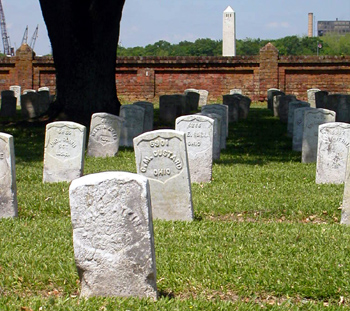 |
| Grave stones of the Chalmette National Cemetery are adjacent to the 19th century Battle of New Orleans battlefield memorial, which rises in the background (Photo by Julie Major). |
Located just six miles from the heart of the French Quarter in New Orleans, the cemetery is adjacent to Chalmette Battlefield, site of the Battle of New Orleans.
The battle was the last engagement between America and England and the last in the War of 1812.
Both sites are part of the National Park Service; together they’re one of six sites that make up the Jean Lafitte National Historical Park and Preserve.
Members of the famed U.S. Colored Troops, named Buffalo Troops by Native Americans, are buried there, as are four veterans from the War of 1812.
A man named Lyons Wakeman, a Union soldier who died of dysentery, was buried here in 1864, but it wasn’t until 1994 that park officials found out Lyons’ first name was actually Sarah. Her grave is in Section 52, Grave 4066.
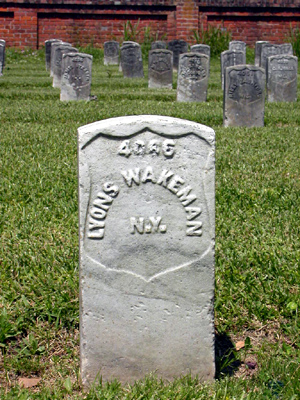 |
The final resting place of Lyons Wakeman, who was determined, more than a century later, to be a woman soldier, Sarah Wakeman, from New York (Photo by Julie Major). |
The 15,500 buried in Chalmette — nearly half of them unknown soldiers whose graves are marked simply with small square stones — fought in every major U.S. war, from the War of 1812 to Vietnam.
“I like to think that when the wind is blowing, the trees tell the stories of the people buried there,” said Coella Longanecker, a park ranger with the Chalmette Battlefield and National Cemetery.
Although the cemetery is the final resting place for some fascinating figures from American history, most tourists who come to New Orleans are totally unaware of the cemetery and battlefield and their place in American history.
Unfortunately, the same can also be said for residents living nearby.
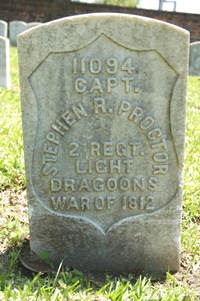 |
| The grave marker of one of the four War of 1812 veterans (Staff photo). |
“This community has not been kind to this battlefield,” Dave Herrera, deputy superintendent for JLNHP&P. “There’s a big disconnect between the city of New Orleans and the battlefield, because the city concentrates on Orleans Parish and we’re in St. Bernard Parish. New Orleans wants to keep the tourist dollars in that parish. Few people even in this parish know of its history.”
That’s not to say the park is unused or neglected. On the contrary: Paths and paved roads on the grounds of the battlefield and cemetery get its fair share of recreational use, which often include walkers, joggers, cyclists and people who just want to find a quiet spot to have a picnic.
Some do come to visit relatives in the cemetery, like John Spisak, a specialist with the U.S. Army National Guard. Spisak was preparing to leave for Iraq the nation’s most recent war, in a few weeks. He stopped at Chalmette to pay his respects to a relative, John Boudreaux, a Civil War veteran buried there.
“I guess I’m getting a little sentimental, since I’m leaving for a war soon,” Spisak said of his visit. “I just wanted to come out here and make sure the grass is cut and the grave is kept up.”
In her 12 years with the NPS, Longanecker has seen all kinds of visitors, and some of them are more outfitted for amusement parks than national parks. Kite fliers, sunbathers, Frisbee throwers and their fun-loving lot don’t constitute a proper use of Chalmette. Nor do weekend treasure seekers who want to sweep the battlefield and cemetery for cannon shot and musket balls.
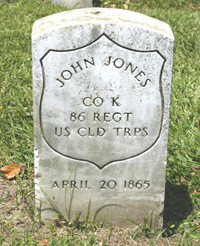 |
| The grave marker of a member of the U.S. Colored Troops who served the Union Army during the Civil War (Staff photo). |
“People actually come into our visitors center with metal detectors and ask if we mind if they walk the grounds with them,” she said.
The NPS minds quite a bit. During the Battle of New Orleans in 1815, the cemetery’s 17.5 acres were originally where most of the British artillery were located. Artifacts from the war are still unearthed from the grounds surrounding the national park, Longanecker said, where the NPS’s watchful eye doesn’t reach.
The cemetery didn’t even come into being until nearly 50 years after the British were driven out of America. By that time, in 1864, the U.S. had another war on its hands, this time between North and South.
The government was searching for places to bury the “damn Yankees” who died on Southern soil.
Because the area was located conveniently downriver of Jackson Barracks hospital in New Orleans, the land was an ideal spot to select for a cemetery.
It’s interesting to note there are no British or Confederate troops buried in Chalmette.
The British dead were buried in mass graves in unknown locations around the battlefield, while Confederate casualties who were initially buried in Chalmette initially were reinterred at other cemeteries around New Orleans in 1868.
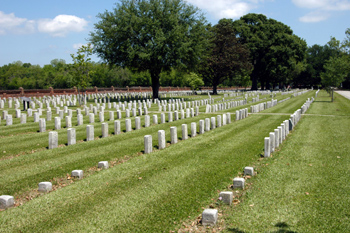 |
Rows and rows of the 15,500 graves honor the service of thousands of Union Soldiers who fought in the Civil War (Staff photo). |
The cemetery hasn’t changed much since then. About the only concession to the 20th century was when the park’s administrators moved the original gates from the river side of the cemetery to the new road on the north side. The cemetery itself was closed to all new burials in 1945, with an exception made during Vietnam.
Today, visitors in New Orleans can reach Chalmette either by car on Hwy. 46 East, or by river on the Creole Queen, a paddle wheel boat that departs from the Riverwalk / Canal Street Dock in the French Quarter twice daily.
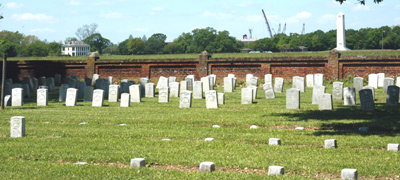 |
The smaller, square markers beside the traditional upright markets (Staff photo). |
If You Go
• The best way to visit Chalmette is by car. From Canal Street, take Rampart Street to St. Claude Avenue east, then onto St. Bernard Highway (La. 46). The entrance to the battlefield is on the right. The park is open from 9 a.m. to 5 p.m. daily except Christmas Day and Mardi Gras.
• Park facilities include a tour road, visitor center and the 1833 Malus-Beauregard House. A small picnic area is provided. Park rangers give Battle of New Orleans talks at 11:15 a.m. and 2:45 p.m. daily. Admission to the park is free.
• The Creole Queen paddleboat takes visitors to Chalmette Battlefield twice daily, at 10:30 a.m. and 2 p.m. Tickets cost $19 for adults, $11 for children over 5 and can be purchased at http://www.neworleanspaddlewheels.com/cruise_battlefield.html. The paddleboat isn’t affiliated with the NPS.
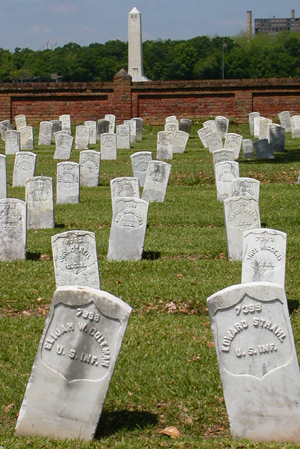
|
Left, Chalmette National Cemetery grave markers lean to the left and right, reflecting a bright spring sun. The markers lean because of the constant settling of the Mississippi River Delta soil. The river is only a few hundred yards from the cemetery (Photo by Julie Major). Below, the final resting place of a Civil War soldier from Vermont (Staff photo). |

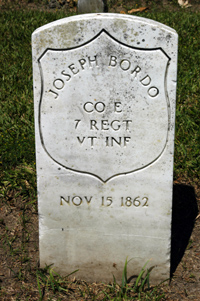
Comments are Closed